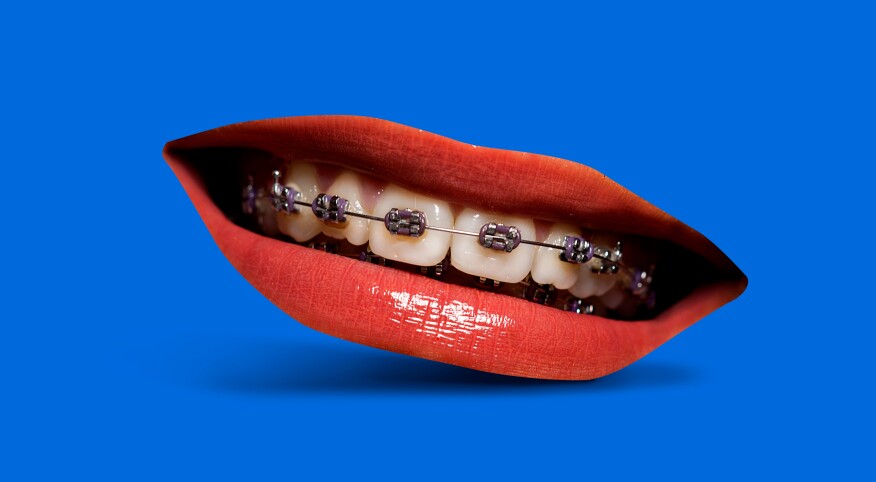Breakouts, frizzy hair and braces — these were the problems I faced as a teenager, and I know I am not alone. I remember sitting in the middle school cafeteria, everyone pulling out their retainers so they could eat lunch (and unfortunately, more than once, I recall people checking the garbage because they accidentally threw their retainer away with the trash — (blech!).
Ironically, this scene from my teenage years is repeating itself as I’ve entered middle age. Yes, I became a “brace face” again in my late 40s, decades after my original orthodontic treatment was completed. For years, I looked in the mirror and felt like my teeth were shifting. My bottom teeth were completely out of alignment, and it made me self-conscious. I started taking more and more photos with a closed-mouth smile.
My concerns are not uncommon. Dr. Myron Guymon, orthodontist and president of the American Association of Orthodontists (AAO), explains, “Nothing is static in our bodies. Over time, things change, and that includes our teeth. If you had braces as a young adult, your teeth could relapse, especially if you haven’t worn your retainer. And even people that never had orthodontics may still experience teeth movement as they age.”
Why Get Braces as An Adult?
The AAO estimates that 1 in 3 orthodontic patients are adults. “Often parents bring their kids into the orthodontist, and when their kid’s treatment is completed, they jump in the chair because they want to improve their own smile,” says Dr. Guymon, who explains the three factors to consider when straightening your teeth — function, stability and aesthetics.
Function: Straight teeth are easier to keep clean and maintain good oral health. “Proper alignment can allow your family dentist to better take care of your teeth,” adds Dr. Guymon. “It’s easier to fix dental problems such as crowns, missing teeth and doing other restorations.”
Stability: A well-aligned bite and straight teeth may help to decrease future dental problems.
Aesthetics: If you don’t like your smile, you are never too old to fix it. “There is no age limit on feeling confident,” says Dr. Guymon.
Treatment Options
Part of the reason more adults are visiting orthodontists is that a lot has changed in terms of treatment options. While metal braces (brackets affixed to the teeth) are still offered, there are alternatives, such as clear ceramic brackets, brackets on the back of the teeth, and aligners. Aligners (often referred to by the brand name “Invisalign”) are especially popular with adult patients. “Aligners are a series of clear plastic appliances that fit over the teeth,” explains Dr. Guymon. “The aligners produce small sequential movements over time.” Since they can be removed, many adults find them easier than fixed appliances. Deciding what orthodontic appliances to utilize is a conversation to have with an orthodontic specialist. “Although it’s possible to seek treatment from someone other than an orthodontic specialist, straightening teeth is all we do,” says Dr. Guymon. “I would recommend visiting an AAO orthodontist and seeing what your treatment options are.”
Treatment Time
Treatment time varies depending on the extent of the tooth movement needed. Some small changes can be made within a few months, but more involved treatment may take longer. With fixed appliances, orthodontists can control the process, but with removable aligners, success relies on the patient’s compliance.
“Trays need to be worn consistently as prescribed, and patients can’t move on to the next aligner tray until the right amount of movement has occurred,” explains Dr. Guymon. “Aligners don’t work if they remain in their case for half the day. If patients don’t wear the trays consistently as directed, they may not get their best results.” Once initial treatment is completed, most patients need to adhere to a retention plan. “Regardless of what type of treatment a patient chooses, the teeth may have a tendency to move back, so it is important to wear a retainer to keep your beautiful smile.”
When You’re Smiling
After seeing several friends’ complete adult orthodontic treatment with positive results, I decided to go for a consultation. I am not sure if I would have committed to a fixed appliance (re-creating my “metal mouth” or “tinsel-toothed teen” days did not appeal to me), but it turned out I was a good candidate for aligners.
Since my motivation was purely cosmetic, my dental insurance policy didn’t cover my treatment, but I decided it was worth the investment. Dr. Guymon recommends checking with your individual insurance company. Costs may be partially covered, or a patient may be able to use a flex spending account, and many orthodontists offer in-house flexible payment plans.
As a teenager, I wasn’t the most agreeable patient (committing no-nos such as chewing gum and not wearing my rubber bands). But as an adult, I am more mature. I promised myself I would comply, especially since I was paying out of pocket.
The initial teeth mold was as gross as I remembered — that process has not changed much. But the remainder of my orthodontic journey was much easier. No “headgear” night appliance, no miserable appointments for tightening or wires poking my cheeks. Each time I changed aligner trays, they were tight, and I had some discomfort for a day or two as my bite adjusted.
Wearing the aligners most of the day was a bit annoying. In the beginning, I felt a little self-conscious and that my speech was garbled. I looked forward to the few hours a day when I could take them out. It was nice to go to a wedding or enjoy a meal out with friends sans braces (although, on several occasions, I took my aligners out and almost threw them away — reminiscent of my middle school cafeteria days).
The best part was that my treatment was completed in less than a year. I am very happy with the results. I am back to smiling with my mouth open, with straight teeth on full display. I feel more confident — not just in my smile but overall.
Have any of you had braces later in life? How did it go? Let us know in the comments below.

Shutterstock
Follow Article Topics: Lifestyle









